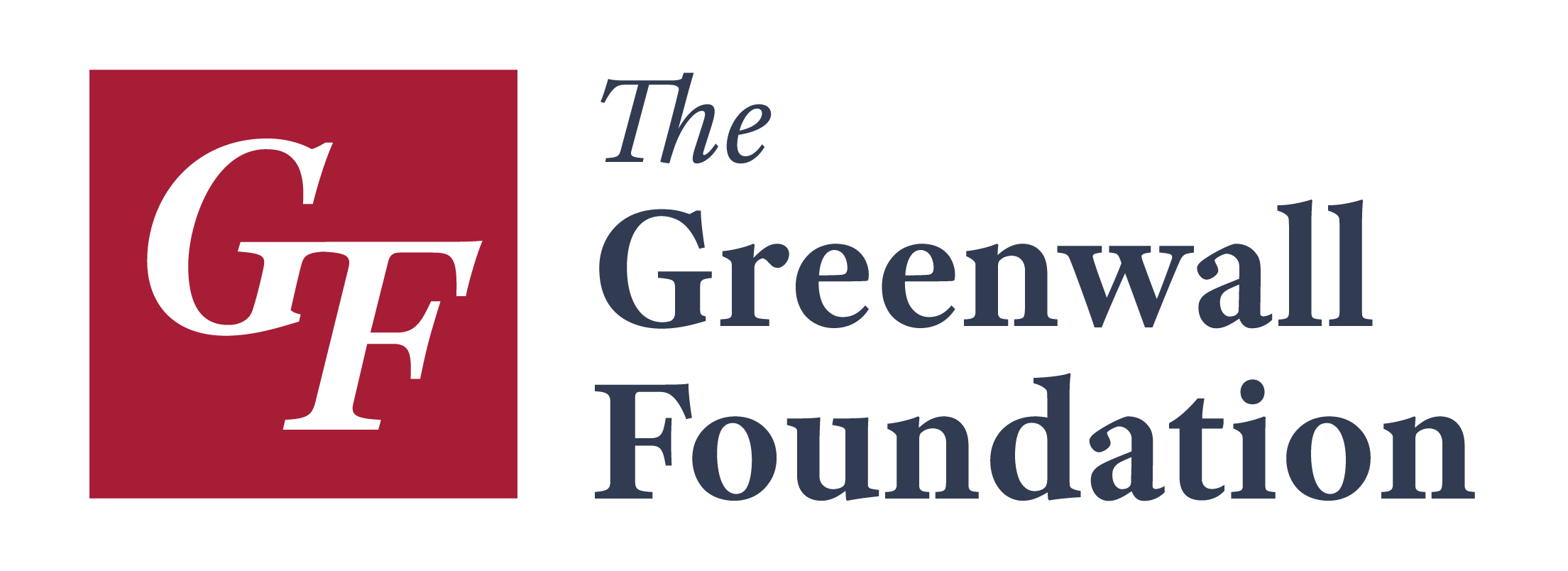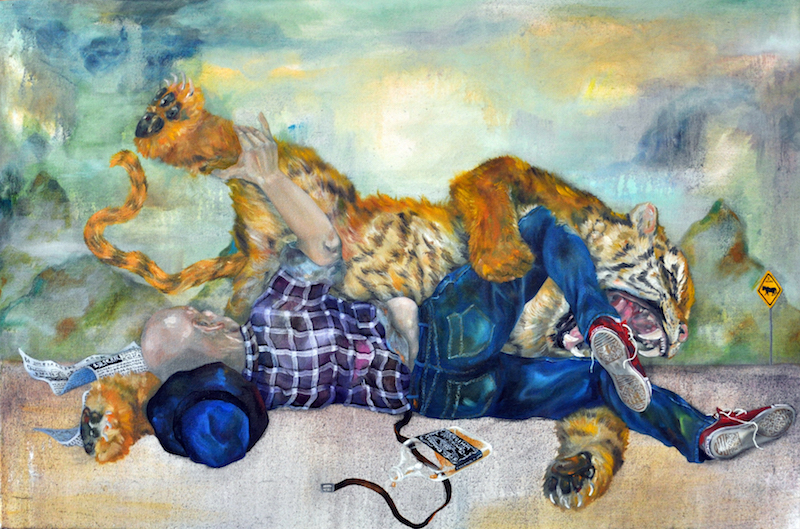Exhibitions - Queens International 2012: Three Points Make a Triangle
Queens International 2012: Three Points Make a Triangle
Eleen Lin, Wusong Fights Tiger / 武松打虎, 22" x 33", Oil on Linen
Queens International 2012: Three Points Make a Triangle is the result of a biannual search through the borough of Queens, NY. This year, themes that emerged while conducting studio visits significantly shaped our selection process. In the end, the artists we included seemed to be combining the rational and the emotional in a search for worlds beyond our own, from the midst of a daily existence saturated by information technology. This state of being seemed to cut not only across medium, but often enough, culture and generation.
“Three points make a triangle” is a phrase inspired by René Daumal’s unfinished novel Mount Analogue (1944), whose connection to this exhibition appeared once we finished our journey through Queens. The adventure describes an expedition by eight explorers to a magical mountain invisible to the human eye and undetectable by human instruments. The explorers follow Father Sogol, a mystical guide who combines scientific knowledge and metaphysical powers to finally find the mountain, which is understood to be a link between the Earth and the Above. The book stops short, halted by Daumal’s death, before the explorers, or the reader, reach the mountaintop, but we know that those who succeed in climbing it achieve Transcendence.
Our experience as “curatorial explorers” of a particular place can be understood as one link to the novel (the three points could represent coordinates that, via the lines described by the journey, create both a triangle and a geographical area). Yet, the connection between the book and the exhibition is much more complex than that, lying in the philosophical “temperaments” (as William James might say) of the works included in the show, in which adventure and exploration, myth and symbol, spirituality and subjectivity, science and technology, future and past are all differently constituted.
Many of the above characteristics are intertwined in science fiction (which grafts technological innovation onto ancient heroic formats), and several artists draw on it directly or indirectly. Adam Shecter’s dreamlike video Last Men is paired with a simulated sci-fi paperback that’s actually a thick flipbook of images of galactic phenomena and poetry; Rachel Mason chose to create a new musical performance at the foot of the Unisphere, Flushing Meadows Corona Park’s very own model Earth[1]; Teng Chao-Ming’s silent footage of a crystalline Arctic Ocean finds an alien world on our own planet, and Sharona Eliassaf’s glowing landscapes in oil bring a frightening extra intensity to the apocalypse. Sam Clagnaz’s video, full of dark magic and ritual, introduced by a contest between a hand and a snake, Jesse Greenberg’s glowing 8-foot resin panel resembling the Rosetta Stone and Allyson Vieira’s spectacularly flawed plaster casts of the bust of Pericles suggest that a pre-Modern past, historical or mythological, is becoming our present or constituting our future. Gintaras Didžiapetris asked us to invite the artist, philosopher, and historian of science Manuel DeLanda to speak. Though at the time of writing this talk is not confirmed, the idea itself invites thought about emergence and simulation — that is, life emerging from non-life — a notion just as relevant to our biotechnological present as to life’s almost unimaginable origins millions of years ago.
Other artists, having digested global Pop, draw on subject matter and symbolism from the Eastern and Western cultural canons — sometimes adding a pinch of psychedelia or cartooning. Eleen Lin’s oils, which show sinuously painted figures from traditional Chinese tales encountering modern urban vices, retain some traditional tropes such as the treatment of flowing water and fabric, while managing to communicate a very contemporary cultural ennui. Scott Grodesky’s fetus-like figures nestled inside other figures surrounded by eyes inside triangles and skulls make up a kind of angular, Masonic holy art. David Kearns’ wall-size view of an urban cemetery includes a greyscale painting-within-a-painting of a nighttime forest with a mysterious glow — a place where one might travel in a nightmare — while Angel Otero’s shadowy silhouette of a woman and child hints at a barely captured memory that could be personal, religious, and art historical all at once.
Abstraction in the East is linked to achieving transcendence (and to process above all). Palden Weinreb’s symmetrical forms, drawn in pencil, fed through architectural software then drawn again, occasionally while saying a mantra; Dieter Kuhn’s all-over graphite and ballpoint doodles, as sheer motor-skills take over large squares of brown paper; and Brian Zegeer’s hypnotic video and performance remake of Alfred Leslie’s own remix Beat classic, Pull My Daisy, could be said to stem from this tradition. Carmelle Safdie’s rubbings of gravestones from a Queens cemetery transferred onto MDF conduct information — and possibly spirits — through a simple, repetitive act. Claudia Peña Salinas’ assemblage of railroad ties, glass figurines, and a carbon paper wall grid is a hybrid form in which objects are chosen as much for their cultural associations as their formal qualities and overall requires our alertness to both space and memory. Media and digital technology’s ubiquity in our lives may be one reason why it is not especially prominent in the show, as artists redirect attention to the body and what it alone can achieve, and sometimes to the traditions that specialize in these achievements.
Borrowing a diagram from another discipline for use as a found form (so that his paintings may or may not be abstract), Becket Bowes’ black and white paintings blur, repeat, and extend the paradoxical mathematical formula known as Euler’s identity. Other artists recreate basic geometries across various mediums, from Tatiana Berg’s humble cone-like structures built from stretchers and canvas and bedazzled with spray-paint, to Karen Chan’s use of video effects to create a depthless dance of watery rectangles, to another work by Safdie — photographs of her thrifted 1980s-era sweaters whose bright, sharp-edged graphics become a collection of floating shapes. Mikhail Gubin’s black-and-white paper collages in debt to the Constructivists, Scott Verhagen’s narrow, bulbous plaster tabletop forms in a range of whites and beiges, Eric Palgon’s all-over acid brights in broad brush-strokes (with titles like Are You The Internet?), and Angelina Gualdoni’s floating cut-out color fields bring the branching of pure abstraction into the 21st century. Robert Lobe’s close-up color photographs of graffiti and torn posters that call up Siskind and Tapies are a form of abstraction in which a person selects and frames, but a machine does the rest.
None of these artists are Luddites or even particularly nostalgic, but understand in different ways that humans have always been a combination of hand and tool. Joe Winter’s sculptural wall works transform office bulletin boards and construction paper into recorders of planetary phenomena, while William Santen’s bittersweet country song with its technical glitches and look of YouTube and Trevor Shimizu’s tender, cartoonish domestic interiors of a couple watching a serial drama on cable remind us that media has become an inextricable component of our personal lives. Another work by Shecter has him sensitively differentiating museum exhibition space-time from Internet space-time. For Three Points, a special selection of his choppy, funny, brightly-colored, seconds-long cartoons — which are available at all times on his website — will be broadcast over disused UHF channels onto televisions placed around the Queens Museum. This gesture illuminates the fact that to have a successful “cross-platform” existence is to live simultaneously in the future and the past.
Another part of the exhibition are three workshops commissioned for the Queens Museum public, which also touch on the show’s overall themes. Matthew Buckingham plans a weekend of research in which child interviewers ask other children questions about the future, in a sincere attempt to understand what we may be in for when they’re in control; Alejandro Cesarco will lead a close analysis of two films that posit translation as a creative act; and Scott Hug organizes a tribute to Bern Porter, the underrecognized Manhattan Project physicist, mid-century media collagist and progenitor of “Sciart.” The workshops, in their format and subject matter, promise to engage visitors in big questions around envisioning possible futures and which tools and compatriots are required to get there.
Each of the works included have a different speculative position on our relationship to the world. There is, however, a common denominator: all artists in Three Points start from the concreteness of personal experience and move towards the abstraction of thought. This self-reflexive act is also in this case a process of self-enquiry, both conscious and unconscious. Perhaps Three Points depicts a contemporary moment in which we are questioning Modern dichotomies such as nature and culture, object and subject, or fact and fiction in order to reintroduce hybrid entities. As such, it may be an attempt to comprehend the-world-and-us as a whole rather than as a fragmented reality.
—Larissa Harris, Jamillah James, Manuela Moscoso
[1] This performance points to the New York City Building’s important role the Modern dream — it was built for the 1939 World’s Fair, housed the United Nations General Assembly, and hosted the 1964 Worlds Fair, of which its giant miniatures, the Panorama of the City of New York and the Unisphere in our front yard are enduring symbols. Though these monuments — and our neighboring ruins, otherwise known as Philip Johnson’s New York State Pavilion — make a strong impact on every visitor, they play a special role in this particular exhibition, as a vision of a technological and social future that is now in the past.
The Queens International 2012 curatorial team selected artists through studio visits, review of recommendations, mailed submissions, and through a new online submission system that yielded more than 650 entries. In total, more than 1,000 submissions were reviewed by the curatorial team highlighting the growing community of young artists energizing the borough.
Discover Images of the Exhibition
Participating Artists
— Tatiana Berg
— Becket Bowes
— Karen Y. Chan
— Sam Clagnaz
— Gintaras Didžiapetris
— Sharona Eliassaf
— Jesse A. Greenburg
— Scott Grodesky
— Angelina Gualdoni
— Mikhail Gubin
— David Kearns
— Dieter Kuhn
— Eleen Lin
— Robert Lobe
— Rachel Mason
— Angel Otero
— Eric Palgon
— Claudia Peña Salinas
— Carmelle Safdie
— William Santen
— Adam Shecter
— Trevor Shimizu
— Teng Chao-Ming
— Scott Verhagen
— Allyson Viera
— Palden Weinreb
— Joe Winter
— Brian Zegeer
Supporters
The Lily Auchincloss Foundation, the Edward and Sally Van Lier Fund of the New York Community Trust, The Greenwell Foundation, and Target. Additional support provided by the New York City Department of Cultural Affairs and the New York State Council on the Arts.






